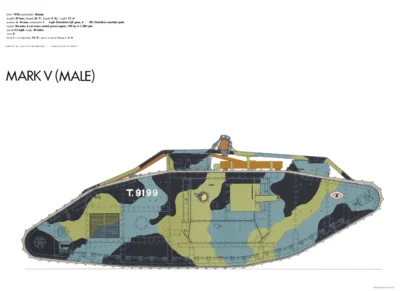Mark V tank (MALE),1918
£15.00
Mark V tank (MALE), 1918 (scroll down for a more detailed Description)
Published 1967 by © Hugh Evelyn Limited; drawn by Malcolm McGregor
Size: c. 47.5 x 34.5 cm [18 ½″ x 13 ½″] may vary slightly from printers’ cut 50 years ago
Printed on white cardstock weighing 140 g/sm2
Print is LARGE size – shipping is the same for 1 to 10 prints (based on largest print size in your order) – see Shipping & Returns
In stock
Description
The first tank was introduced in 1916 but the Mark V was the first capable of being driven by one man. A new engine was designed for the Mark V by Ricardo which was more powerful and more efficient. The armour thickness was increased to 14 mm making it impervious to the German ‘K’ bullet, and the second turret on the roof was re-designed as a proper fighting chamber. The unditching beam could now be attached to the tracks without leaving the tank. It consisted of an iron-bound baulk slightly longer than the tank’s width carried on the rails over the roof. The tank’s chief drawback was its poor ventilation due to the re-positioning of the radiators inside the hull. Crews suffered badly from heat and fumes. A long approach march led to men often drooping with fatigue before a battle. The new tank first saw action at the Battle of Hamel on 4th July 1918 and then replaced the earlier models with the Tank Battalion. The greater manoeuvrability afforded by the more powerful engine, and thicker armour, proved it to be the most successful of the British heavy tanks in the war. A total of four hundred were built before the Armistice: two hundred male and two hundred females (the latter without the 6 pounder guns). Several variations were constructed to boost trench-crossing capacity with experiments in 1917 with the Tadpole Tail on the Mark IV. The Mark V One-Star tanks were employed in the Battle of Amiens in August 1918 when each carried forward four extra machine gun teams who were to aid cavalry. The scheme misfired due to the tanks’ bad ventilation, and the men were in no fit state to fight when they arrived. The Mark V Two-Stars was like the previous model but was built as a new tank and powered by a 255-hp Ricardo engine. A few were completed after the Armistice and were largely used for experiments in bridge-laying and mine-destroying. It can be seen today at The Tank Museum, Bovington, Dorset, UK.
Additional information
| Weight | 0.0229 kg |
|---|---|
| Dimensions | 47.5 × 35.5 cm |





